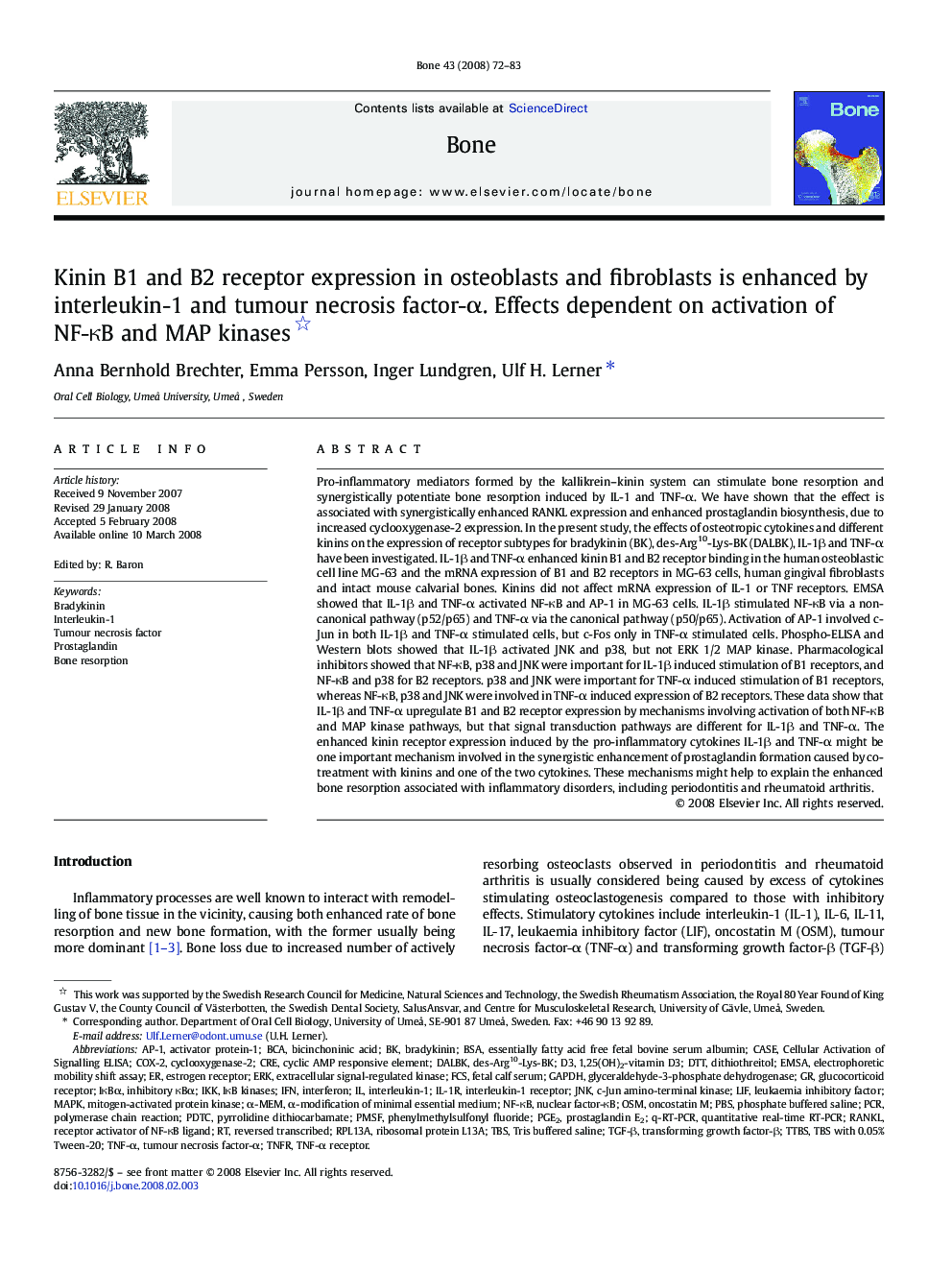| Article ID | Journal | Published Year | Pages | File Type |
|---|---|---|---|---|
| 5892546 | Bone | 2008 | 12 Pages |
Abstract
Pro-inflammatory mediators formed by the kallikrein-kinin system can stimulate bone resorption and synergistically potentiate bone resorption induced by IL-1 and TNF-α. We have shown that the effect is associated with synergistically enhanced RANKL expression and enhanced prostaglandin biosynthesis, due to increased cyclooxygenase-2 expression. In the present study, the effects of osteotropic cytokines and different kinins on the expression of receptor subtypes for bradykinin (BK), des-Arg10-Lys-BK (DALBK), IL-1β and TNF-α have been investigated. IL-1β and TNF-α enhanced kinin B1 and B2 receptor binding in the human osteoblastic cell line MG-63 and the mRNA expression of B1 and B2 receptors in MG-63 cells, human gingival fibroblasts and intact mouse calvarial bones. Kinins did not affect mRNA expression of IL-1 or TNF receptors. EMSA showed that IL-1β and TNF-α activated NF-κB and AP-1 in MG-63 cells. IL-1β stimulated NF-κB via a non-canonical pathway (p52/p65) and TNF-α via the canonical pathway (p50/p65). Activation of AP-1 involved c-Jun in both IL-1β and TNF-α stimulated cells, but c-Fos only in TNF-α stimulated cells. Phospho-ELISA and Western blots showed that IL-1β activated JNK and p38, but not ERK 1/2 MAP kinase. Pharmacological inhibitors showed that NF-κB, p38 and JNK were important for IL-1β induced stimulation of B1 receptors, and NF-κB and p38 for B2 receptors. p38 and JNK were important for TNF-α induced stimulation of B1 receptors, whereas NF-κB, p38 and JNK were involved in TNF-α induced expression of B2 receptors. These data show that IL-1β and TNF-α upregulate B1 and B2 receptor expression by mechanisms involving activation of both NF-κB and MAP kinase pathways, but that signal transduction pathways are different for IL-1β and TNF-α. The enhanced kinin receptor expression induced by the pro-inflammatory cytokines IL-1β and TNF-α might be one important mechanism involved in the synergistic enhancement of prostaglandin formation caused by co-treatment with kinins and one of the two cytokines. These mechanisms might help to explain the enhanced bone resorption associated with inflammatory disorders, including periodontitis and rheumatoid arthritis.
Keywords
TTBSERKRPL13ABCAPGE2TGF-βLIFPMSFFCSNF-κBAP-1TNF-α receptorIKKα-MEMDALBKIκBαIL-1RQ-RT-PCRTNFRPDTCc-jun amino-terminal kinaseIκB kinasesGAPDHribosomal protein L13AOSMCREDTTJnkPBSTBSCOX-2RANKL1,25(OH)2-vitamin D3BSAMAPKquantitative real-time RT-PCRElectrophoretic mobility shift assayoncostatin MinterferonIFNinterleukin-1bradykininbicinchoninic acidtransforming growth factor-βBone resorptionTris buffered salinetumour necrosis factor-αpyrrolidine dithiocarbamatedithiothreitolfetal calf serumEMSA یا electrophoretic mobility shift assay Cyclooxygenase-2leukaemia inhibitory factortumour necrosis factorcyclic AMP responsive elementTNF-αnuclear factor-κBPhosphate buffered salinephenylmethylsulfonyl fluorideCASEpolymerase chain reactionPCRactivator protein-1mitogen-activated protein kinaseProstaglandin E2prostaglandinextracellular signal-regulated kinaseglyceraldehyde-3-phosphate dehydrogenaseEstrogen receptorinterleukin-1 receptorglucocorticoid receptorreceptor activator of NF-κB ligand
Related Topics
Life Sciences
Biochemistry, Genetics and Molecular Biology
Developmental Biology
Authors
Anna Bernhold Brechter, Emma Persson, Inger Lundgren, Ulf H. Lerner,
